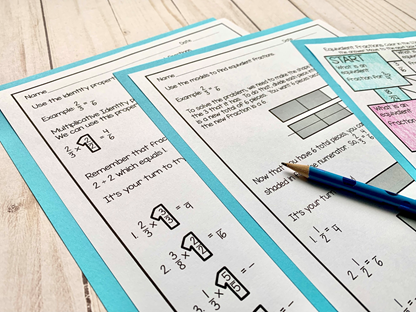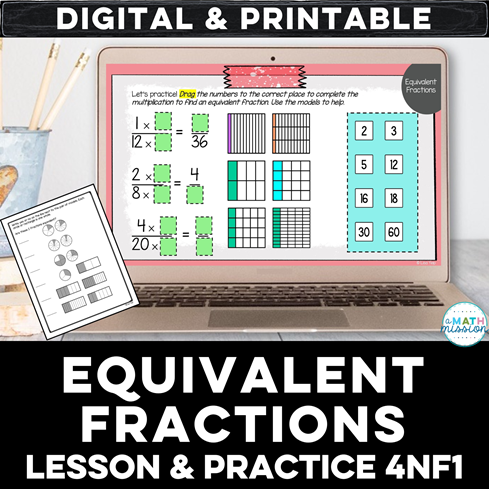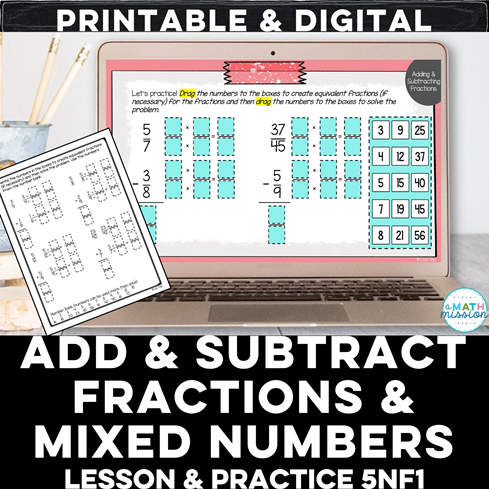You’ve just started your unit on adding and subtracting fractions by mentioning equivalent fractions to your class.
Instead of students nodding in understanding, wide and confused eyes stare back at you. Glancing at the class, all but a few of your students are acting as if equivalent fractions are foreign words that they’ve never heard before.

The lack of knowledge is going to put you days behind in your lessons, but you can’t skip right to adding and subtracting with unlike denominators until your students have a firm grasp on equivalent fractions. Scratching your lesson for the day, you switch gears to spend the time teaching equivalent fractions.
But what is the best way to teach equivalent fractions…and fast?
I’ve been freshly reacquainted to the fun of teaching fractions to a 5th grader this year. My youngest child is currently in 5th grade.
She came home with that wonderful, exciting fraction homework one day.
Crying in frustration (yes, her and me), I quickly realized that she had little to no understanding of equivalent fractions…thanks, Pandemic.
There was no way I could work with her on finding a common denominator and then equivalent fractions without first backing up and teaching her equivalent fractions.
Luckily, I had a trick up my sleeve, and some resources that I had already created that I could use to give her a crash course on finding equivalent fractions.
The Quick Tip-“The Big One”
Start with modeling, move to using “The Big One”, and put that knowledge to use on basic problems.
So what is “The Big One”?
Start teaching equivalent fractions by asking students what 4 × 1 is, then what 5 × 1 is, and so on. The students will usually point out how easy that is, which is exactly what I want them to do because finding equivalent fractions is the same as multiplying by one.
This is where “The Big One” comes into play.
Point out that the word equivalent means equal, so we are finding equal fractions (fractions that if modeled with a fraction bar would have the exact same amount shaded, assuming the fraction bars are the same size. The only difference is the number of pieces each fraction bar has in it).
Carefully explain how to find equivalent fractions. NEVER say that we are multiplying the fraction by 2 or by 3, because that is not what we are doing. We are always multiplying the fraction by 1, “The Big One” to find an equivalent fraction.
Take a look at the problem in the picture below:

In this problem, “The Big One” is 3/3. Make a big deal of explaining that 3/3 means the same thing as 3 divided by 3, which equals one.
Have Some Fun to Solidify the Learning
Let the students come up with other fractions that can be written in “The Big One”. They love to come up with fractions like 1,672/1,672. Let them do this. Let them get silly with huge numbers that still will equal 1. By allowing them the silliness, you are solidifying the understanding of “The Big One” in their minds.
Draw “The Big One” over the fraction that you are multiplying by so that students visually remember that they need to multiply by 1 each and every time they are finding an equivalent fraction.
Have students draw “The Big One” on all the problems they complete, and with their homework. Some students will end up drawing “The Big One” all year when dealing with equivalent fractions. Others will grasp the concept quickly and move away from it. If you’re interested in the activity pictured, you can find it here.
And if you’re wondering how things turned out between my daughter and me after that fraction homework, I can happily report that she did very well on the homework and the fraction unit too.
She came home with a big smile and a big A on her test on fractions. I’d say that’s a win!! Now onto decimals!
Additional Equivalent Fractions Resources
Some students just need lots of visual practice with finding equivalent fractions. If you have some students like that, here’s an interactive activity that students can mostly complete on their own. Find that activity here.

If you’re a 5th grade teacher and also want a resource that is beneficial for practice with finding common denominators and adding and subtracting fractions and mixed number with unlike denominators, you can find that here.


